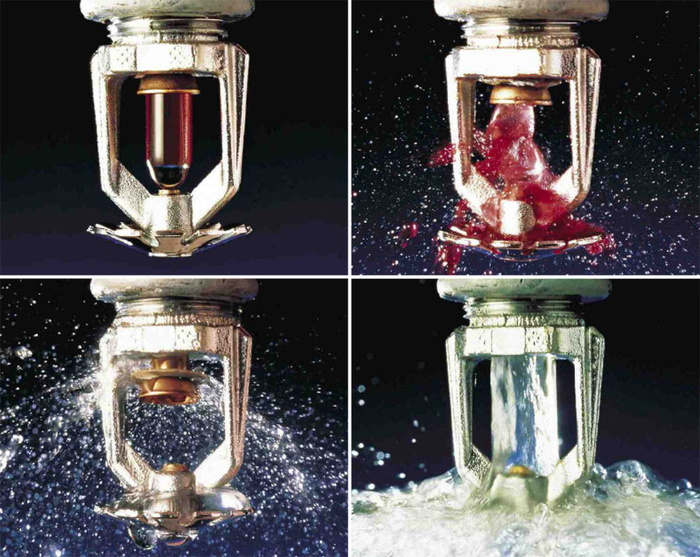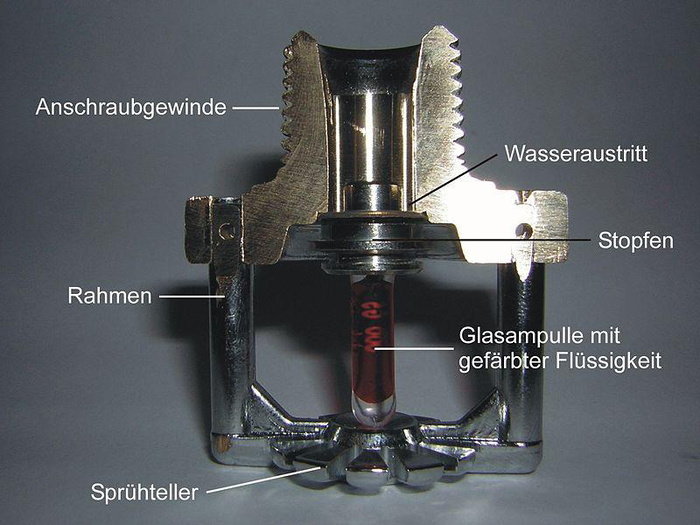Sprinkler systems
Extinguishing water is sprayed specifically at the source of the fire
Functional unit consisting of nozzle, closure and heatdependet trigger element
The development of the first sprinkler system dates back to the middle of the last century. This technology stemmed from the American textile industry which often endured devastating fires due to the highly flammable material cotton. Through the installation of an open piping network which could be manually pressurised with water in the event of a fire, lives and machinery could be protected effectively for the very first time. Over the years, a wide range of sprinkler systems were developed and successfully implemented in many different areas.
The English and German word "sprinkler" stood and still stands for a functional unit consisting of a nozzle, a closure and a heat-dependent release mechanism. Nowadays, sprinkler systems have naturally become more complex and efficient. Since the founding of the company, ACCURO has worked extensively in the area of sprinkler technology and has designed and constructed countless systems over the past few decades. The company's strengths - expertise and committed employees coupled with flexibility - laid the foundations for ACCURO's success. Today, ACCURO is in a position to design and construct sprinkler systems for any project and according to all standard regulations e.g. VdS, TRVB, FM or NFPA.
The basic principle of a sprinkler system:
- Piping networks fitted with closed nozzles.
- The nozzles open separately when heated by fire or hot flue gases.
- Extinguishing water is sprayed selectively on the source of the fire.
- Water is also sprayed on the surrounding area and therefore prevents the fire from spreading.
- Only a certain number of sprinklers open - the source of the fire is brought under control and often extinguished
- The cooling effect of water - extraction of large quantities of heat - conversion into steam.
Sprinkler system types
Wet system
For wet systems, the entire piping network leading up to the sprinklers is filled with water. Once the sprinkler system is activated, the extinguishing water flows over the wet alarm valve and the open sprinklers and targets the source of the fire. The wet alarm valve simultaneously alerts a constantly manned station via a pressure switch alarm. Wet systems should only be used in places which are not exposed to a freezing or overheating (+95 °C) of the extinguishing water in the piping network during the year.
Dry system
Dry systems are only filled with water up to the dry alarm valve. The sprinkler piping network for this system type is then filled with pressurised air. If a sprinkler opens in the event of a fire, the pressurised air first escapes and the dry alarm valve then releases the extinguishing water to the sprinklers. However, the different specifications in the guidelines for dry systems must be followed as closely as possible.
Tandem system
Tandem systems are wet systems which are installed downstream to pressurised pipelines via one or several dry alarm valves for areas susceptible to frost or high temperatures e.g. small porches. The size of tandem systems is extremely limited.
Pre-controlled sprinkler systems Typ A
This system type is a dry sprinkler system in which the alarm valve station is first activated through an automatic fire alarm system and not through the opening of a sprinkler and the flooding of the piping network. Water is only released after the activation of a sprinkler. This system type can be installed in places where a false activation of the system could lead to considerable damage from the extinguishing water.
Pre-controlled sprinkler systems Typ B
In contrast, the Type B pre-controlled sprinkler system is a dry system, for which the alarm station is activated either through an automatic fire alarm system or through a drop in pressure in the sprinkler piping network. However, the extinguishing water is only released if a sprinkler is open. This pre-controlled system type is used in places where the installation of a wet system is not possible due to the environmental influences, but where a rapid spread of fire is likely (e.g. in high-bay warehouses).
Simple and effective sprinkler systems
- Sprinkler systems offer fire detection and extinguishing functions in a single system.
- Sprinklers only extinguish areas which need to be extinguished. Sprinklers outside the source of the fire therefore remain closed.
- The extinguishing water released reduces smoke and dangerous substances.
- The cooling effect achieved through the extinguishing water increases the safety of the rescue forces.
- Extinguishing water is the most cost-effective extinguishing medium and is available almost worldwide.
- Sprinkler systems return to a 'ready for further use' condition very quickly after a fire.
- A wide range of solutions can be used to effectively tackle a fire.
- These include flexibility and possibilities to adapt a building's architectural structure.
In essence, sprinkler systems are therefore automatic extinguishing systems which both detect and localise the fire, alert rescue forces and suppress or extinguish the fire.

Typical areas of application for sprinkler systems:
Sprinkler systems protect people, assets and the environment. They prevent an incipient fire that has not been detected in time, from turning into a widespread fire.
Typical areas of use:
- Timber-processing companies
- Industrial companies
- Logistics centres
- Production halls
- High rack warehouses
- Warehouses
- Underground car parks
- Shopping centres
- Exhibition halls
- Hotels
- Hospitals and care homes
- High-rise buildings
- Offices
- Airports and much more

We advise you on the various extinguishing systems
Contact us:




